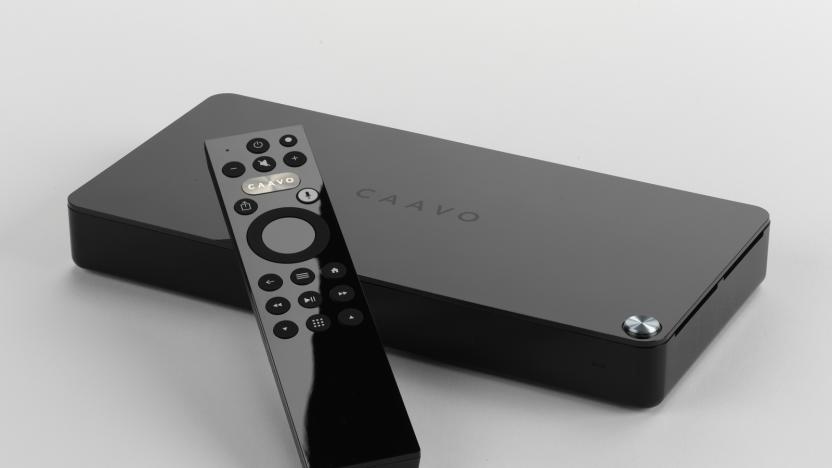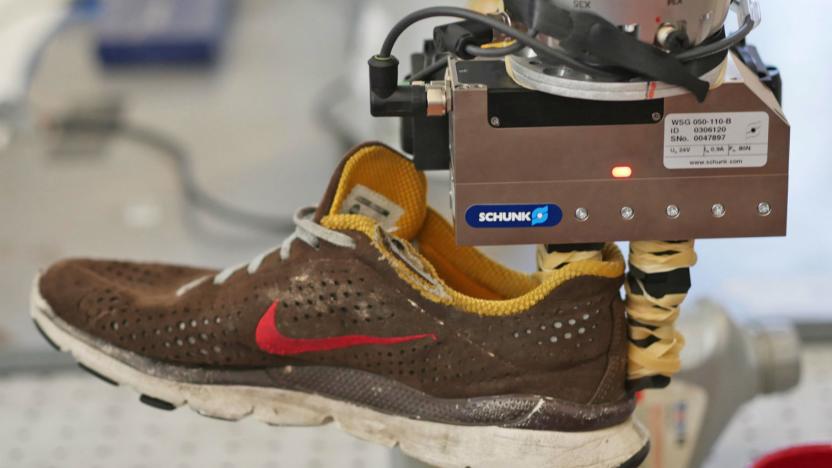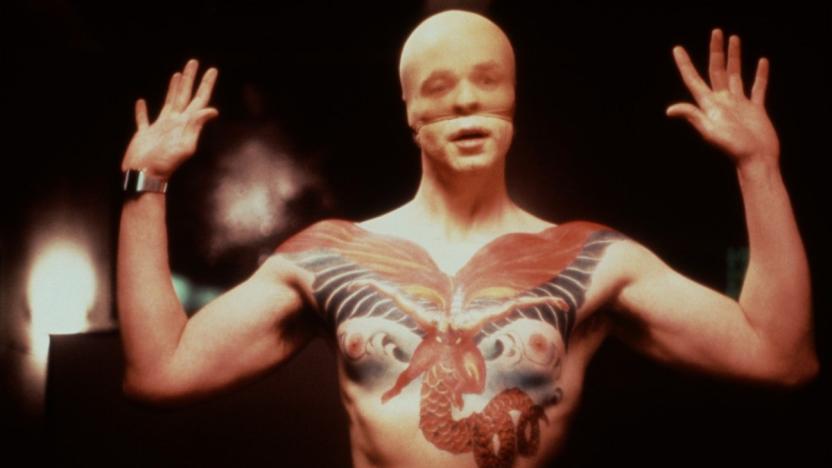machinevision
Latest

Caavo's universal streaming remote packs machine vision for $100
Caavo's first shot at a smart universal remote (and the hub to match) was clever, but expensive -- at $399, you had to be a serious enthusiast to enjoy it. You might not have those qualms this time around. The company has unveiled the Control Center, a combination remote and hub that includes much of the intelligence with a $100 up-front price (more on that later). It gets there in part by cutting many of the bordering-on-overkill features you saw in the original hardware. Gone are the wood panels, the hidden browser to sign you into services, an infrared adapter and half of the eight HDMI inputs. The core, however, is familiar: it's a media center overseer that uses machine vision to juggle all your devices.

MIT machine vision system figures out what it's looking at by itself
Robotic vision is already pretty good, assuming that it's being used within the narrow bounds of the application for which it's been designed. That's fine for machines that perform a specific movement over and over, such as picking an object off of an assembly line and placing it into a bin. However for robots to become useful enough to not just pack boxes in warehouses but actually help out around our own homes, they'll have to stop being so myopic. And that's where the MIT's "DON" system comes in.

Caavo’s voice-enabled universal remote ships February 14th
The Caavo universal TV control system, which is aimed at simplifying home TV setups through machine vision, is set to ship on February 14th, The Verge reports. Initially planned to ship last June, the $399 system boasts the ability to control and navigate up to eight devices -- say, for example, a Roku, an Apple TV, a DVR and an Xbox One -- removing the need for a bunch of different remotes, for the most part. It even offers voice control so you can say, "Watch Bob's Burgers," and it will start playing it through one of your streaming devices. You can also set the system to play certain services, like Hulu, on a specific device, like your Fire TV.

After Math: Do you see?
It was an illustrative week for machine vision. Sony's high-speed eyes allow robots to see at 1000 FPS, IBM trained a neural network to spot schizophrenia, and MIT's AI knows what's in your meal just by looking at it. Numbers, because how else do you measure your myopia?

Panasonic's new image sensor could help cars see in the dark
Panasonic's new image sensor tech is designed for taking shots in the dark. Literally. The company has made an advancement that provides "electrical control of the near infrared (NIR) light sensitivity of the same pixel in an organic CMOS image sensor." In English, that means it can take photos in near pitch-black without losing detail or resolution -- and it does so without the need for a mechanical IR cut filter.

ICYMI: Soon flying UAVs could pick stuff up; carry it away
try{document.getElementById("aol-cms-player-1").style.display="none";}catch(e){}Today on In Case You Missed It: A large format hexacopter with mechanical gripper arms is all set to swoop in on your backyard and move some chairs around. Going by the Prodrone's YouTube video, it can carry 10 kilograms.

Researchers want to use wasps to improve UAV flight plans
After spending the past decade studying ground-nesting wasps a team of researchers from the Australian National University believe that they've unlocked the secret to the insects' uncanny homing abilities -- one they hope can be applied to future UAV development. Modern, autonomous UAVs have to be laden with high resolution cameras, GPS radios and a slew of other high-tech gadgetry in order to know where they are and where they're going. Wasps, on the other hand, only need their compound eyes and a daily refresher flight.

'Machine vision' MFT cam arrives for robotics, remote photography, special effects
If you're asking yourself "where's the shutter button on that thing?" then a new machine vision camera from SVS-Vistek, the SVCam-evo "Tracer" is probably not for you. However, it may spark tinkerers or other niches as the boxy look belies its capabilities. For starters, it packs a micro four thirds mount with a Truesense CCD sensor, opening the door to lenses a cut above the usual industrial fare. You'll also get frame rates of 146, 85, 40 and 21 fps at 1, 2, 4 and 8-megapixels, respectively, along with auto gain; exposure, focus and electric zoom control; PC software for basic image capture; and a GigE Vision interface. The latter -- along with a Windows and Linux SDK -- will make the device ideal for those who don't mind digging into code for applications like robotics, aerial and remote imaging or even "special effects and unique POV" cinematography. The rest of us won't be able to just fire it up and take pictures, however, and as for the price? There's no word yet on that or availability, but don't expect a consumer-friendly figure.

Kinect sensor bolted to an iRobot Create, starts looking for trouble
While there have already been a lot of great proof-of-concepts for the Kinect, what we're really excited for are the actual applications that will come from it. On the top of our list? Robots. The Personal Robots Group at MIT has put a battery-powered Kinect sensor on top of the iRobot Create platform, and is beaming the camera and depth sensor data to a remote computer for processing into a 3D map -- which in turn can be used for navigation by the bot. They're also using the data for human recognition, which allows for controlling the bot using natural gestures. Looking to do something similar with your own robot? Well, the ROS folks have a Kinect driver in the works that will presumably allow you to feed all that great Kinect data into ROS's already impressive libraries for machine vision. Tie in the Kinect's multi-array microphones, accelerometer, and tilt motor and you've got a highly aware, semi-anthropomorphic "three-eyed" robot just waiting to happen. We hope it will be friends with us. Video of the ROS experimentation is after the break.

DARPA sets sights on cameras that understand
DARPA wants to let you all know that its plans for the robot apocalypse are still going strong. The agency's got IBM working on the brains, has an RFI out on the skin, and is handling propulsion and motor control in-house. Next up? Eyeballs. In order to give its robots the same sort of "visual intelligence" currently limited to animals, DARPA is kicking off a new program called The Mind's Eye with a one-day scientific conference this April. The goal is a "smart camera" that can not only recognize objects, but also be able to describe what they're doing and why, allowing unmanned bots and surveillance systems to report back, or -- we're extrapolating here -- make tactical decisions of their own. To be clear, there's no funding or formal proposal requests for this project quite yet. But if the code does come to fruition, DARPA, please: make sure autoexec.bat includes a few Prime Directives.

Matrox Iris GT smart camera brings Windows CE to Atom-land
Matrox's new Iris GT "smart camera" doesn't mark the first time that the Atom processor and Windows CE have run into each other, but it's certainly one of the most interesting encounters, even if it's one that most folks likely won't see first hand. Apparently, the camera is intended to be used in various "machine vision" applications, like locating and reading barcodes or measuring the geometry of 2D objects, but we think you'll agree that it has one other, not quite official use written all over it: robot eye. The camera's specs certainly seem to make that a possibility, and include that ever-present 1.6GHz Atom processor, 256MB of RAM, 1GB of flash storage, a gigabit Ethernet port, and USB 2.0 and RS232 ports, not to mention accommodations for a number of interchangeable lenses -- it's even dust-proof and "washable." No word on a price just yet, but Matrox says it'll be available sometime in the first quarter of next year.[Via jkOnTheRun]







